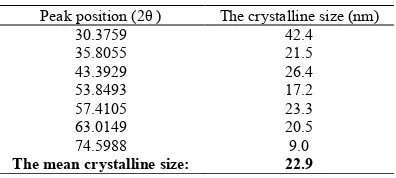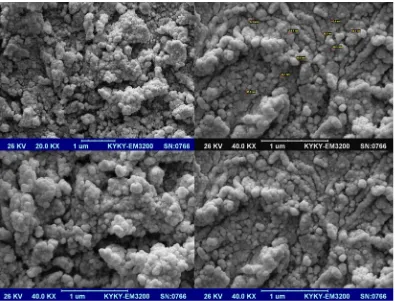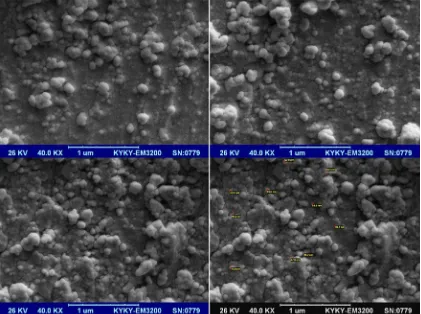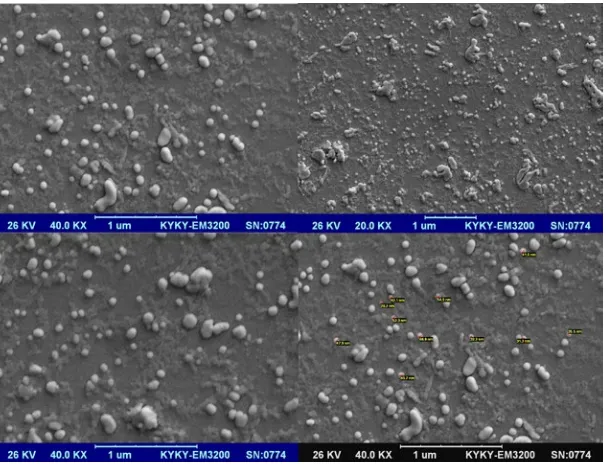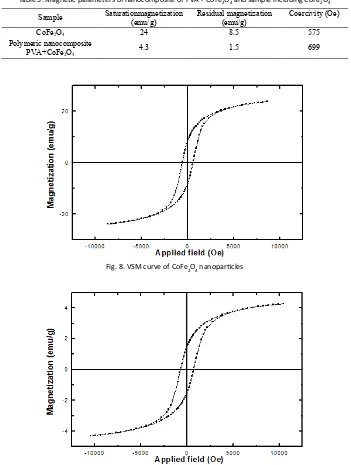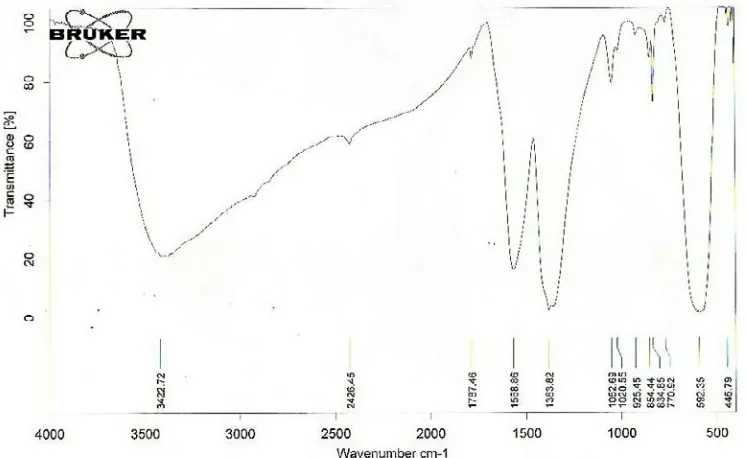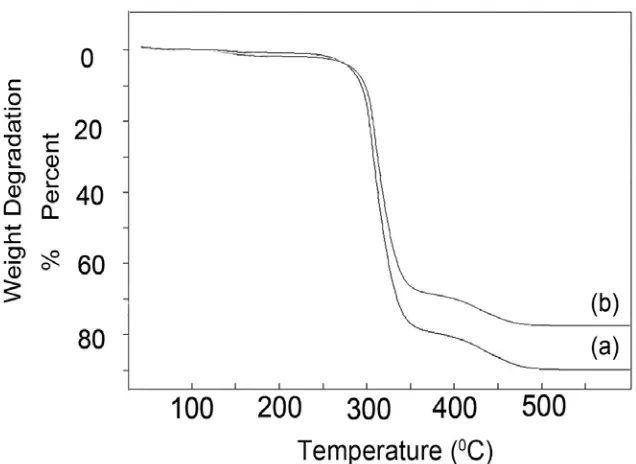J Nanostruct 9(2): 365-375, Spring 2019
RESEARCH PAPER
Magnetic Investigation of Microwave Synthesized and Thermal
Stable Polyvinyl Alcohol-Cobalt Ferrite Nanocomposites
Matin Karbasi 1, Farnaz Maghazeii 2,* and Davood Ghanbari 3
1 Nano Physics MS Student, Arak Branch, Islamic Azad University, Arak, Iran.
2 Mathematics and Physics Department, Science Faculty, Arak Branch, Islamic Azad University, Arak, Iran. 3 Department of Science, Arak University of Technology, Arak, Iran
*Corresponding Author Email: f_maghazeii@yahoo.com ARTICLE INFO
Article History:
Received 27 September 2018 Accepted 05 December 2018 Published 01 April 2019
Keywords:
Cobalt Ferrite Nanoparticles Magnetic Behavior Nanostructure Polymer Nanocomposite Thermal Stability
ABSTRACT
How to cite this article
Karbasi M, Maghazeii F, Ghanbari D. Magnetic Investigation of Microwave Synthesized and Thermal Stable Polyvinyl Alcohol-Cobalt Ferrite Nanocomposites. J Nanostruct, 2019; 9(2): 365-375. DOI: 10.22052/JNS.2019.02.018
CoFe2O4 nanoparticles was prepared using heating in various times by simple
microwave method at power about 600W. Water, ethylene glycol and their combination were used as solvent. X-ray diffraction pattern (XRD) analysis was performed for evaluation of structural characterization of samples. We also used scanning electron microscopy (SEM) to evaluate the effects of various parameters of heating time and solvent type on mean grain size and nanostructure of the samples. Our results showed that with changing of these parameters, we can control the nanostructure and grain size of prepared samples. In addition, we produced polymeric nanocomposite of
PVA/CoFe2O4 using polyvinyl alcohol films. The thermal stability of it in
comparison to PVA polymer was assessed by thermal gravimetric analysis (TGA). Also the nanostructures of polymer nanocomposite were analyzed by SEM. To evaluate the magnetic parameters of samples, vibrating sample magnetometer (VSM) analysis were done. Also the spectrum of PVA polymer and polymer nanocomposite were drawn by FT-IR. Our results confirmed that the nanostructures, magnetic behavior and thermal stability of the prepared nanocomposite are acceptable for needed applications.
INTRODUCTION
Magnetic nanoparticles have attracted a great deal of attention due to their promising applications in biomedicine, as catalysts [1]. Among the many magnetic nano-particles, Cobalt ferrite is an important member of ferrite family and is characterized by moderate saturation magnetization, high coercively, mechanical hardness and chemical stability [2]. The magnetic properties of these nanoparticles have been found to be highly dependent on the size and shape and purity of them [3]. Recently, great efforts have been made by various groups to achieve a fine-tuning of size of ferrite nanoparticles by employing different synthesis techniques and varying experimental parameters such as heating rate, and quantity of surfactants [4].
Various methods have been developed for the synthesis of nanoferrites, like sonochemical reactions, reaction, sol-gel, microwave plasma, host template, CVD, [5]. Among the various methods of nonmaterials preparation, microwave method is the most simple and effective in chemical reactions and synthesis of nanomaterials and nanostructures at relatively low temperature [6]. Some general advantages of microwave-assisted synthesis over conventional are the following: 1) increase in the reaction rate as a result of high heating rates, 2) wide range of reaction conditions, 3) high yields of reaction, 4) selective reactivity due to different absorption properties, 5) excellent control of the reaction conditions, 6) simple operation, enabling quick and easy optimization of
This work is licensed under the Creative Commons Attribution 4.0 International License.
366
M. Karbasi et al. / Polyvinyl Alcohol-Cobalt Ferrite Nanocomposites
J Nanostruct 9(2): 365-375, Spring 2019 experimental parameters [7].
On the other hand, polymer/ magnetic ferrite nano composites have been an extremely active field of research because of their significant potential applications in various fields. Magnetic nanoparticles areabsorbent as nanofillersin nanocomposites. It is important to control the size and shape of the nanoparticles and to ensure these are well dispersed within the composite matrix [8,9]Because of the high surface to volume ratio of the nanoparticles, effect of these additives is much more remarkable than that observed in conventional composites [10]. Embedding magnetic cobalt ferrite nano-particles in polymer matrix prevents their agglomeration, improves their chemical stability and bio-compatibility [8]. Polyvinyl alcohol (PVA) is an important water-soluble transparent polymer, and is extensively used in industries due to the excellent chemical and physical properties, non-toxicity, good chemical resistance, good film formation capacity, biodegradability and high crystal modulus [11].
In this work we synthesized Cobalt ferrite by simple and fast microwave method in a green solvent. Then for preparation of magnetic polymer matrix nanocomposites, Cobalt ferrite nanoparticles were added to the polyvinyl alcohol. Nanoparticles and nanocomposites were characterized by scanning electron microscopy (SEM), X-ray diffraction (XRD) and vibrating sample magnetometer (VSM) analysis. The results confirm by the results of thermo-gravimetry analysis. By adding of Cobalt ferrite nanoparticles to PVA polymer, thermal resistance and flame retardancy of the matrix was improved to higher temperatures.
MATERIALS AND METHODS Materials and devices
In this research we used Co(OAC)24H2O, Fe(NO3)9H2O, PVA, C2H2(OH2), NaOH and distilled water from Merck Company. The simple kitchen microwave oven from Panasonic Company with power of 600W was used for heating and the time measured by standard chronometer. Water and ethylene glycol alone and in combination were used as solvent. To determine the structural characterization of samples, we used XRD analysis with CuKα (λ = 0.15418 nm) in the range of 2θ= 10-80֯. The SEM images were obtained by LEO instrument model 1455VP. The magnetic properties of samples were analysed by VSM device made by
“Magnetic Kavir Kashan” Co. Iran,in an applied magnetic field sweeping between ±10000 Oe.
Infrared spectrophotometer of Perkin-Elmer was used to determine the spectrum for Cobalt ferrite nanoparticles and polymer nanocomposites.
Thermogravimetry device model Perkin-Elmer was used for determination of thermal stability of PVA film polymer and our nanocomposite.
CoFe2O4 nanoparticle synthesis
0.5 gof Co(OAC)24H2O and 1.62 g of Fe(NO3)9H2O were dissolved in 100 ml distilled water and was stirred by magnetic stirrer to produce a clear solution. Then about 30 ml of NaOH solution were added to adjust the pH=10. After 5 minutes in room temperature, the solution was centrifuged in 3000rpm to sediment any unsolved particles. The solution was put in desiccator to complete dry out. After that, the product was heated by microwave oven (600 W) for 5 minutes. This product was used as control sample. The same procedure also repeated but the heating cycle changed to 2 minutes’ heat.
The solvent also changed to pure ethylene glycol and mixed water-ethylene glycol in proportion of 90%-10% and heating cycle of 5 minutes.
Preparationof (PVA/CoFe2O4) polymeric
nano-composite
Various amounts of 0.5, 0.9, 0.95 and 0.99 g of PVA were dissolved in 25 ml of hot water to produce various concentrations of polymer solution. The solutions poured on a smooth surface and wait to completely dry out in room temperature to make thin film PVA polymers. Then the previously prepared solutions of Cobalt ferrite nanoparticles in water (in proportion of 1:9) were added to polymer films. After about 3 hours the water completely evaporated and resultant gelatinous matrix poured on smooth clear surface to make thin polymer nanocomposite films of PVA/CoFe2O4.
Fig. 1 shows the practical algorithm how to synthesize Cobalt ferrite nanoparticles and polymeric nanocomposite of PVA/CoFe2O4.
RESULT AND DISCUSSION XRD analysis
367 J Nanostruct 9(2): 365-375, Spring 2019
M. Karbasi et al. / Polyvinyl Alcohol-Cobalt Ferrite Nanocomposites
cubic phase (JCPDS No.: 74-2081) with Fd-3m space group which is consistent with pure cobalt ferrite.
The equation of Scherrer can determine the size of crystallines:
Dc=Kλ/βCosθ (1)
In this equation, β is the width of the observed diffraction peak at its half maximum intensity (FWHM), K is the shape factor, which takes a value of about 0.9, and λ is the X-ray wavelength (CuKα radiation, equals to 0.154 nm). Table 1 summarizes
the size of the crystallines for each peak of XRD Fig.1. Schematic of samples including Cobalt ferrite and polyvinyl alcohol nanocomposite preparation.
Fig. 2. XRD pattern of CoFe2O4 nanoparticles
Peak position (2θ ) The crystalline size (nm) 30.3759 42.4 35.8055 21.5 43.3929 26.4 53.8493 17.2 57.4105 23.3 63.0149 20.5 74.5988 9.0
The mean crystalline size: 22.9
Table 1. The size of crystalline for each peak of XRD pattern from Scherrer equation and the mean crystalline size of
368
M. Karbasi et al. / Polyvinyl Alcohol-Cobalt Ferrite Nanocomposites
J Nanostruct 9(2): 365-375, Spring 2019 Fig. 3. SEM images of cobalt ferrite nanoparticles with water solvent and heating time of 2 minutes
369 J Nanostruct 9(2): 365-375, Spring 2019
M. Karbasi et al. / Polyvinyl Alcohol-Cobalt Ferrite Nanocomposites
curves. The last line shows the mean crystalline size of sample.
Generally, when the nucleation and growth comes to a balance, nanoparticles will reach to their maximum size. With change in primary circumstances of synthesize, one could change the nanostructure and properties of the samples. So the properties could be controlled regarding the usage of products.
SEM analysis of samples
Fig. 3 shows the SEM images of sample including Cobalt ferrite with distilled water solvent and 2 minutes time of heating (600 W). Due to low temperature, the surface diffusion is limited and nucleation occurred in areas with the lowest surface energy in this sample. The mean grain size calculated which it was about 45 nm.
Fig. 4 shows the images of SEM for Cobalt ferrite sample with distilled water as solvent and 5 minutes heating time (600 W). The mean grain size was about 46 nm which is not so different, but the surface was more uniform and grains
were almost the same size. This may be due to increase of surface diffusion because of the higher than temperature. We used this sample as control sample.
The effect of solvent was also studied in this research. Fig. 5 shows the images of SEM for sample including Cobalt ferrite which heated for 5 minutes (600W) in a mixed solvent of distilled water+ ethylene glycol (9:1). In this case, the mean grain size equals 55 nm, which is greater than the control sample. By changing of solvent to pure ethylene glycol and fixing the heating time in 5 minutes (600W), we produced another sample. Fig. 6 shows the images of SEM for this sample. We can see more uniform surface and almost the same size particles. The mean diameter of particles in this sample was about 84 nm. Increasing of temperature and surface diffusion because of highly absorption of energy by means of ethylene glycol, caused these suitable changes in the nanostructure of sample. But water as green solvent is being preferred to ethylene glycol in many applications.
370
M. Karbasi et al. / Polyvinyl Alcohol-Cobalt Ferrite Nanocomposites
J Nanostruct 9(2): 365-375, Spring 2019 Fig. 7.SEM images of polyvinyl alcohol nanocomposites compounding with Cobalt ferrite
371 J Nanostruct 9(2): 365-375, Spring 2019
M. Karbasi et al. / Polyvinyl Alcohol-Cobalt Ferrite Nanocomposites
Sample Mean grain diameter (nm) Morphology of surface CoFe2O4(heating time:2 min.
solvent: water ) 45 Small and large grains with holes between them CoFe2O4(heating time:5 min.
solvent: water) 46 Same size grains, uniform surface CoFe2O4(heating time:5 min.
solvent: water +ethylene glycol) 55 Increase of grain size in comparison with water solvent CoFe2O4(heating time:5 min.
solvent: ethylene glycol) 84 Very large grains, uniform surface Polymeric nanocomposite of PVA+
CoFe2O4 42
Dispersion of nanoparticles between polymeric chains of PVA
Sample Saturationmagnetization (emu/g) Residual magnetization (emu/g) Coercivity (Oe)
CoFe2O4 24 8.5 575
Polymeric nanocomposite
PVA+CoFe2O4 4.3 1.5 699
Table 2. The results of SEM analysis for all of samples
Table 3. Magnetic parameters of nanocomposite of PVA + CoFe2O4 and sample including CoFe2O4
Fig. 8. VSM curve of CoFe2O4 nanoparticles
372
M. Karbasi et al. / Polyvinyl Alcohol-Cobalt Ferrite Nanocomposites
J Nanostruct 9(2): 365-375, Spring 2019 Finally, SEM images of polyvinyl alcohol
nanocomposite compounding with Cobalt ferrite are shown in Fig. 7.Presence of nano additives in polymeric matrix was confirmed by SEM images. Nano ferrite were appropriately dispersed between polymeric chains of polyvinyl alcohol. The average
particle size is calculated to be around 42 nm. The results of SEM analysis for all of samples are briefly shown in Table 2.
The average size less than 100 nm for particles confirms that all of our samples’ nanostructure included nanoparticles.
Fig. 10. FT-IR spectrum of Poly vinyl alcohol
373 J Nanostruct 9(2): 365-375, Spring 2019
M. Karbasi et al. / Polyvinyl Alcohol-Cobalt Ferrite Nanocomposites
Magnetic properties of polyvinyl alcohol nanocomposite compounding with Cobalt ferrite
Table 3 shows the magnetic parameters at room temperature for sample including CoFe2O4 and polymeric nanocomposite of PVA/ CoFe2O4from their VSM curves that are shown in Fig. 8 and Fig. 9 respectively. It can be seen that in nanocomposite, saturation magnetization decrease and coercivity increase in comparison with another one. The magnetic property of the prepared nanocomposites is an essential characteristic of a heterogeneous nanocomposite since materials with this magnetic behaviour have low tendency in inter-particles agglomeration caused by dipole-dipole interaction in comparison with ferromagnetic nanocomposites. The results also indicate that nanocomposite formation give rise to coercivity enhancement. In summary, sample including CoFe2O4 shows the ferromagnetic behavior and by adding Cobalt ferrite nanoparticles to PVA polymer, this magnetic property is increased.
FT-IR spectrum of the samples
Fig. 10 shows the FT-IR spectrum of the Polyvinyl alcohol. FT-IR spectrum of Polyvinyl alcohol showed significant peaks at 3500, 2900, 1500,1400,1000 and 400-600 cm-1. The band at
3500 cm-1 was assigned to O –H stretching vibration
mode. The band at 2900 cm-1 was assigned to the
C–H stretching vibration mode. The band at 1500 cm-1 was assigned to C=O stretching vibration
mode. The band at 1400 cm-1 was assigned to the between C-O and C=O stretching vibration mode. The band at1000 cm-1 was assigned to C–O
stretching vibration mode. The band at 400-600 cm-1 was assigned to Metal–Oxygen stretching
vibration mode.
And Fig. 11 shows the FT-IR spectrum of the polyvinyl alcohol. FTIR spectrum of polyvinyl alcohol showed significant peaks at 3500, 2900,
1500, 1400, 1000 and 400-600 cm-1. The band at
3500 cm-1 was assigned to O –H stretching vibration
mode. The band at 2900 cm-1 was assigned to the
C–H stretching vibration mode. The band at 1500 cm-1 was assigned to C=O stretching vibration
mode. The band at 1400 cm-1 was assigned to
the between C-O and C=O stretching vibration
mode. The band at1000 cm-1 was assigned to C–O
stretching vibration mode. The band at 400-600 cm-1 was assigned to Metal–Oxygen stretching
vibration mode.
Thermal resistance of polymeric nanocomposite of
PVA/CoFe2O4
Thermal resistance of PVA/CoFe2O4 nanoc-omposite and pure polyvinyl alcohol polymer were determined using thermo-gravimetric analysis and compared with each other.
Fig. 12 shows thermal resistance graphs of PVA/CoFe2O4 nanocomposite (a curve) and PVA polymer (b curve). We can see that in both of them, thermal destruction was started from 300֯C but for
PVA polymer was very faster than nanocomposite, so that PVA polymer was almost destructed in 450֯C. Cobalt ferrite nanoparticles which
have been scattered on the surface of polymer prevent Oxygen and heat from penetrating into the inner parts of polymer. This process make nanocomposite much more fireproof.
The effect of nanostructure on the flame retardant properties has been considered using UL-94 test. In UL-94 a bar shape specimen of plastic 130× 13 × 3 mm is positioned vertically and held from the top. A Bunsen burner flame is applied to the specimen twice (10 s each). A V-0 classification is given to material that is extinguished in less than 10 s after any flame application, drips of particles allowed as long as they are not inflamed. A V-1 classification is received by a sample with maximum combustion time <30 s, drips of particles allowed as long as they are not inflamed. The sample is classified V-2 if it satisfies the combustion time criteria of V-1, but flaming drips are allowed. Materials are ranked as N.C. in UL-94 tests when the maximum total flaming time is above 50 s. The sample is classified HB when slow burning on a horizontal specimen; burning rate < 76 mm/min for thickness < 3 mm [12-14].
UL-94 tests for PVA and PVA/CoFe2O4
nanocomposites are V-1 and V-0 respectively. The results show that the magnetic nanostructure can enhance the flame retardant property of the PVA matrix. Exfoliated cobalt ferrite nanostructures can act as barriers which decrease product volatilization and thermal transport during decomposition of the polymer.
CONCLUSION
374
M. Karbasi et al. / Polyvinyl Alcohol-Cobalt Ferrite Nanocomposites
J Nanostruct 9(2): 365-375, Spring 2019 Fig. 12.Thermal resistance graph of CoFe2O4- PVA nanocomposites (a) and PVA polymer (b)
size of samples were studied. The most uniform surface was produced with 5 minutes heating time. The results of samples with ethylene glycol as solvent were much better than water solvent samples, but water as green solvent is being preferred to ethylene glycol in many applications. The results confirmed that all synthesized nanostructures were formed from nanoparticles with average diameter size less than 100 nm.
In addition, we produced polymeric nano-composite of PVA/CoFe2O4. VSM analysis results confirmed ferromagnetic behavior of our nanocomposite. Thermogravimetry analysis showed that thermal resistance of PVA nanocomposite was more than PVA polymer.
Cobalt ferrite nanoparticles which have been scattered on the surface of polymer prevent Oxygen and heat from penetrating into the inner parts of polymer. This process make nanocomposite much more fireproof.
CONFLICT OF INTERESTS
The authors declare that there is no conflict of interests regarding the publication of this paper.
REFERENCES
1. Lu LT, Dung NT, Tung LD, Thanh CT, Quy OK, Chuc NV, et al. Synthesis of magnetic cobalt ferrite nanoparticles
with controlled morphology, monodispersity and composition: the influence of solvent, surfactant, reductant and synthetic conditions. Nanoscale. 2015; 7(46):19596-610.
2. Xavier S, Thankachan S, Jacob BP, Mohammed EM. Structural and electrical properties of neodymium substituted cobalt ferrite nanoparticles. IOP Conference Series: Materials Science and Engineering. 2015;73:012093.
3. Hedayati K, Azarakhsh S, Saffari J, Ghanbari D. Photo catalyst CoFe2O4–CdS nanocomposites for degradation of toxic dyes: investigation of coercivity and magnetization. Journal of Materials Science: Materials in Electronics. 2016;27(8):8758-70.
4. Rao KS, Choudary GSVRK, Rao KH, Sujatha C. Structural and Magnetic Properties of Ultrafine CoFe2O4 Nanoparticles. Procedia Materials Science. 2015;10:19-27.
5. George T, Sunny AT, Varghese T. Magnetic properties of cobalt ferrite nanoparticles synthesized by sol-gel method. IOP Conference Series: Materials Science and Engineering. 2015;73:012050.
6. Singh AK, Nakate UT. Microwave Synthesis, Characterization and Photocatalytic Properties of SnO2 Nanoparticles. Advances in Nanoparticles. 2013;02(01):66-70.
7. Barreto G, Morales G, Cañizo A, Eyler N. Microwave Assisted Synthesis of ZnO Tridimensional Nanostructures. Procedia Materials Science. 2015;8:535-40.
8. Rashidi S, Ataie A. A comparison study of polymer/cobalt ferrite nano-composites synthesized by mechanical alloying route. Journal of Ultrafine Grained and Nanostructured Materials. 2015;48(2):59-67.
375 J Nanostruct 9(2): 365-375, Spring 2019
M. Karbasi et al. / Polyvinyl Alcohol-Cobalt Ferrite Nanocomposites
10. Tang C-M, Tian Y-H, Hsu S-H. Poly(vinyl alcohol) Nanocomposites Reinforced with Bamboo Charcoal Nanoparticles: Mineralization Behavior and Characterization. Materials. 2015;8(8):4895-911.
